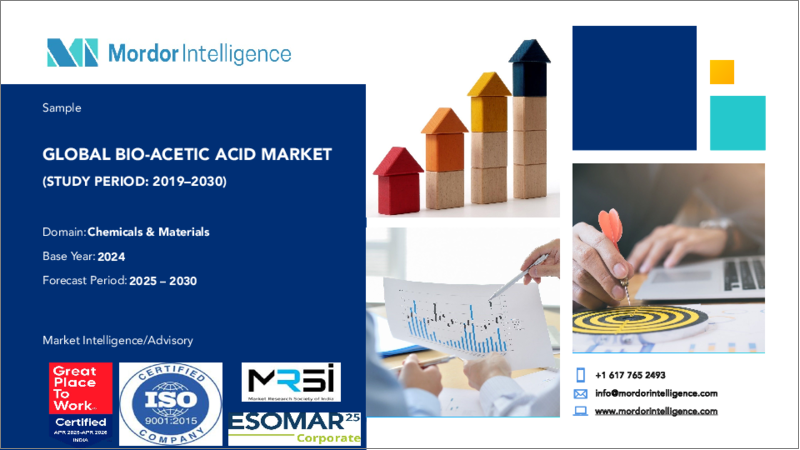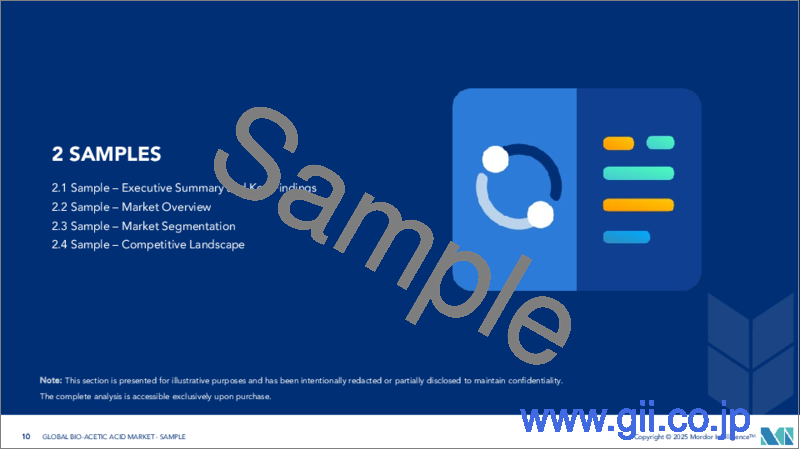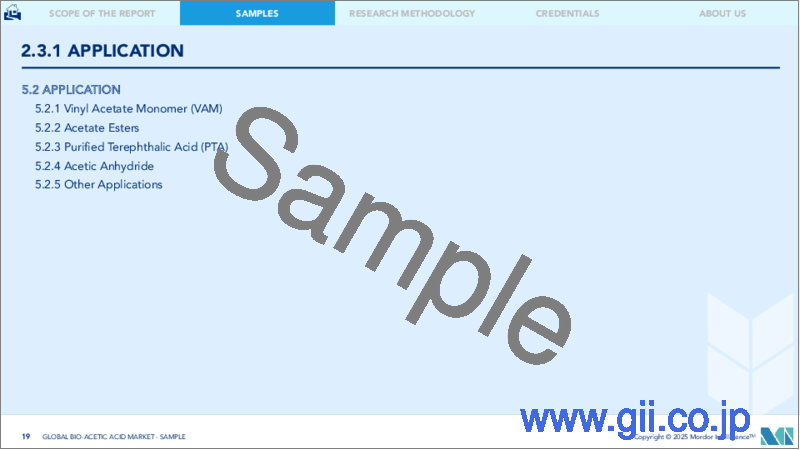|
|
市場調査レポート
商品コード
1683127
バイオ酢酸市場-市場シェア分析、産業動向・統計、成長予測(2025年~2030年)Bio-Acetic Acid - Market Share Analysis, Industry Trends & Statistics, Growth Forecasts (2025 - 2030) |
||||||
カスタマイズ可能
適宜更新あり
|
|||||||
| バイオ酢酸市場-市場シェア分析、産業動向・統計、成長予測(2025年~2030年) |
|
出版日: 2025年03月18日
発行: Mordor Intelligence
ページ情報: 英文 120 Pages
納期: 2~3営業日
|
全表示
- 概要
- 目次
バイオ酢酸市場規模は2025年に140万トンと推定され、予測期間(2025~2030年)のCAGRは3%を超え、2030年には162万トンに達すると予測されます。

バイオ酢酸市場は2020年にCOVID-19の悪影響を受けました。建設活動と自動車製造活動はパンデミック・シナリオのために一時的に停止しており、接着剤、塗料、コーティング剤、プラスチック、複合材などのエンドユーザー産業製品の配合に使用される酢酸ビニルモノマーの需要が最小限に抑えられ、その結果、バイオ酢酸の市場需要にマイナスの影響を与えました。しかし、すべての産業が生産プロセスを再開したため、市場は成長軌道を維持しました。
バイオベースで再生可能な化学品と酢酸ビニルモノマー(VAM)の需要の増加は、予測期間中の市場需要を牽引すると予想されます。
その反面、代替原料の入手可能性や原料価格の変動が市場の成長を妨げると予想されます。
生産効率を高めるための新たな分離技術の開発は、予測期間中、市場開拓の好機となりそうです。
アジア太平洋が最も高い市場シェアを占めており、予測期間中、市場を独占すると予想されます。
バイオ酢酸市場の動向
市場を独占する酢酸ビニルモノマー(VAM)セグメント
- 酢酸は主に酢酸ビニルモノマー(VAM)の製造に使用されます。酢酸エチルや酢酸ブチルといった酢酸の主要エステルは、塗料やコーティングの溶剤として一般的に使用されています。
- 酢酸ビニルモノマー(VAM)は、水性塗料、接着剤、防水コーティング剤、紙・板紙用コーティング剤の製造に使用され、建築、塗料・コーティング、プラスチック、溶剤、接着剤、繊維など、さまざまな最終用途産業で使用されます。
- 世界的には、酢酸ビニルモノマー消費量の伸びは中国と米国の需要に牽引されています。
- インドでは、2023年にAsian Paints Ltdの完全子会社であるAsian Paints(Polymers)Private Limited(APPPL)が、グジャラート州ダヘジに酢酸ビニル-エチレンエマルジョン(VAE)と酢酸ビニルモノマー(VAM)の製造施設を設立すると発表しました。製造施設設立の概算費用は210億インドルピー(2億5,124万米ドル)です。
- Motilal Oswal Financial Services(MOFSL)によると、酢酸ビニルモノマー(VAM)は最大の酢酸誘導体で、世界需要の40%を占めています。
- 2023年10月、米国を拠点とする多国籍コントラクターであるKBRとその日本のアセチル技術パートナーである昭和電工は、インドにおける草の根的な酢酸ビニルモノマー(VAM)プラントのサービスを提供するため、アジアン・ペインツ社に選定されました。契約条件では、KBRは年産10万トンのプラントの技術ライセンス、基本エンジニアリング、専有設備を記載しています。一方、昭和電工は触媒と操業ノウハウを記載しています。
- このように、VAM市場におけるこのような動向はすべて、予測期間中にバイオ酢酸市場の需要を促進すると予想されます。
アジア太平洋が市場を独占する
- アジア太平洋は世界最大のバイオ酢酸消費国であり、最も急成長している市場です。
- 酢酸は重要な化学試薬であり、プラスチック清涼飲料ボトル、写真フィルム、塗料、コーティング剤の製造に使用される工業薬品です。建設活動の増加は、使用される塗料やコーティング剤の需要を押し上げ、酢酸の需要を押し上げています。
- アジア太平洋では酢酸ビニルモノマー(VAM)の需要が伸びており、中国が重要な役割を果たしています。中国とインドは人口が多いため、世界市場にとって大きな消費ポテンシャルを秘めています。
- インドでは、国内VAM需要の100%が輸入でまかなわれています。最大の誘導体である酢酸ビニルモノマー(VAM)は、酢酸消費量の34%を占めています。シンガポールは主要な輸入国であり、インドが輸入するVAMの総量の半分以上を占めています。
- 2023年12月、中国の江蘇蘇宝化学は鎮江新区で酢酸ビニルとEVAを統合したプロジェクトへの投資を発表しました。この野心的なプロジェクトは2段階で展開され、まず年間33万トンの生産能力を持つVAM生産工場の建設から始まる。
- 2023年初め、INEOSとLOTTE Corporationは、韓国の蔚山に第3のVAMプラントを増設し、VAM生産能力を450キロトンから700キロトンに拡大する計画を発表しました。
- 上記の要因は、アジア太平洋におけるバイオ酢酸消費需要の増加に寄与しています。
バイオ酢酸産業概要
バイオ酢酸市場は統合されています。主要参入企業(順不同)には、LENZING AG、Godavari Biorefineries Ltd、Airedale Group、Novozymes A/S(Novonesisグループ)、Sekabなどがあります。
その他の特典
- エクセル形式の市場予測(ME)シート
- 3ヶ月間のアナリストサポート
目次
第1章 イントロダクション
- 調査の前提条件
- 調査範囲
第2章 調査手法
第3章 エグゼクティブサマリー
第4章 市場力学
- 促進要因
- バイオベースと再生可能化学品に対する需要の増加
- 酢酸ビニルモノマー(VAM)の需要増加
- 抑制要因
- 代替品の入手可能性
- 原料の入手可能性と価格の不安定性
- 産業バリューチェーン分析
- ポーターのファイブフォース分析
- 供給企業の交渉力
- 消費者の交渉力
- 新規参入業者の脅威
- 代替品の脅威
- 競合の程度
第5章 市場セグメンテーション(市場規模(数量ベース))
- 原料
- バイオマス
- トウモロコシ
- トウモロコシ
- 砂糖
- その他の原料
- 用途
- 酢酸ビニルモノマー(VAM)
- 酢酸エステル
- 高純度テレフタル酸(PTA)
- 無水酢酸
- その他
- 地域
- アジア太平洋
- 中国
- インド
- 日本
- 韓国
- マレーシア
- タイ
- インドネシア
- ベトナム
- その他のアジア太平洋
- 北米
- 米国
- カナダ
- メキシコ
- 欧州
- ドイツ
- 英国
- イタリア
- フランス
- スペイン
- 北欧諸国
- トルコ
- ロシア
- その他の欧州
- 南米
- ブラジル
- アルゼンチン
- コロンビア
- その他の南米
- 中東・アフリカ
- カタール
- アラブ首長国連邦
- ナイジェリア
- エジプト
- 南アフリカ
- その他の中東・アフリカ
- 中東・アフリカ
- サウジアラビア
- 南アフリカ
- その他の中東・アフリカ
- アジア太平洋
第6章 競合情勢
- M&A、合弁事業、提携、協定
- 市場シェア(%)**/ランキング分析
- 主要企業の戦略
- 企業プロファイル
- AFYREN SA
- Airedale Group
- btgbioliquids
- GODAVARI BIOREFINERIES LTD
- Jubilant Ingrevia Limited
- LanzaTech
- LENZING AG
- Novozymes A/S(Novonesis Group)
- Sekab
- SUCROAL SA
第7章 市場機会と今後の動向
- 生産効率を高める新しい分離技術の開発
The Bio-Acetic Acid Market size is estimated at 1.40 million tons in 2025, and is expected to reach 1.62 million tons by 2030, at a CAGR of greater than 3% during the forecast period (2025-2030).

The bio-acetic acid market was negatively impacted by COVID-19 in 2020. Construction activities and automotive manufacturing activities were on a temporary halt owing to the pandemic scenario, which had minimized the demand for vinyl acetate monomer used in the formulation of these end-user industry products such as adhesives, paints, coatings, plastics, and composites, in turn, negatively impacted the market demand for bio-acetic acid. However, the market retained its growth trajectory due to all the industries' resumed production processes.
Increasing demand for bio-based and renewable chemicals and vinyl acetate monomers (VAM) is expected to drive market demand during the forecast period.
On the flip side, the availability of alternatives and volatility in the feedstock availability and prices are expected to hinder the growth of the market.
Developing new separation technologies to increase production efficiency is likely to act as an opportunity for the market studied over the forecast period.
Asia-Pacific accounts for the highest market share and is expected to dominate the market during the forecast period.
Bio-Acetic Acid Market Trends
The Vinyl Acetate Monomer (VAM) Segment to Dominate the Market
- Acetic acid is mainly used to manufacture vinyl acetate monomer (VAM). The major esters of acetic acid, such as ethyl acetate and butyl acetate, are commonly used as solvents for paints and coatings.
- Vinyl acetate monomer (VAM) is used to produce water-based paints, adhesives, waterproofing coatings, and paper and paperboard coatings that can be used in various end-use industries such as construction, paints and coatings, plastic, solvents, adhesives, and textiles.
- On the Global front, growth in vinyl acetate monomer consumption is driven by demand in China and the United States.
- In India, in 2023, Asian Paints (Polymers) Private Limited (APPPL), a wholly-owned subsidiary of Asian Paints Ltd, announced the setting up of a manufacturing facility of vinyl acetate-ethylene emulsion (VAE) and vinyl acetate monomer (VAM) at Dahej, Gujarat. The approximate cost of setting up the manufacturing facility would be INR 2,100 crore (USD 251.24 million).
- According to the Motilal Oswal Financial Services (MOFSL), vinyl acetate monomer (VAM) is the largest acetic acid derivative, accounting for 40% of its global demand.
- In October 2023, US-based multinational contractor KBR and its Japanese acetyls technology partner, Showa Denko, were selected by Asian Paints to provide services for a grassroots vinyl acetate monomer (VAM) plant in India. Under the contract terms, KBR will provide a technology license, basic engineering, and proprietary equipment for a 100,000 t/y plant. In contrast, Showa Denko will provide the catalysts, along with its technical operating know-how.
- Thus, all such trends in the VAM market are expected to drive the demand for the bio-acetic acid market during the forecast period.
Asia-Pacific to Dominate the Market
- Asia-Pacific is the largest consumer of bio-acetic acid globally and is the fastest-growing market.
- Acetic acid is an important chemical reagent and industrial chemical used in producing plastic soft drink bottles, photographic films, paints, and coatings. The increasing construction activities boost the demand for paints and coatings to be used, boosting the demand for acetic acid.
- Asia-Pacific accounts for the growing demand for vinyl acetate monomer (VAM), a crucial role that China is playing. Due to the huge population in China and India, they pose a huge consumption potential for the global market.
- In India, 100% of domestic VAM demand is met through imports. The largest derivative, vinyl acetate monomer (VAM), accounts for 34% of acetic acid consumption. Singapore is a major importer, with more than half the share of the total quantity of VAM imported by India.
- In December 2023, Jiangsu Sopo Chemical in China announced investing in a vinyl acetate and EVA-integrated project in the Zhenjiang New District. This ambitious project will unfold in two stages, beginning with the construction of a VAM production plant with a substantial capacity of 330 thousand tons per year.
- In early 2023, INEOS and LOTTE Corporation announced plans to expand VAM production capacity from 450 kilotons to 700 kilotons by adding a third VAM plant in Ulsan, South Korea, with expectations for completion by the end of 2025.
- The factors above contribute to the increasing demand for bio-acetic acid consumption in Asia-Pacific.
Bio-Acetic Acid Industry Overview
The bio-acetic acid market is consolidated. Some major players (not in any particular order) include LENZING AG, Godavari Biorefineries Ltd, Airedale Group, Novozymes A/S (Novonesis Group), and Sekab.
Additional Benefits:
- The market estimate (ME) sheet in Excel format
- 3 months of analyst support
TABLE OF CONTENTS
1 INTRODUCTION
- 1.1 Study Assumptions
- 1.2 Scope of the Study
2 RESEARCH METHODOLOGY
3 EXECUTIVE SUMMARY
4 MARKET DYNAMICS
- 4.1 Drivers
- 4.1.1 Increasing Demand for Bio-based and Renewable Chemicals
- 4.1.2 Increasing Demand for Vinyl Acetate Monomers (VAM)
- 4.2 Restraints
- 4.2.1 Availability of Alternatives
- 4.2.2 Volatility in the Feedstock Availability and Prices
- 4.3 Industry Value Chain Analysis
- 4.4 Porter's Five Forces Analysis
- 4.4.1 Bargaining Power of Suppliers
- 4.4.2 Bargaining Power of Consumers
- 4.4.3 Threat of New Entrants
- 4.4.4 Threat of Substitute Products and Services
- 4.4.5 Degree of Competition
5 MARKET SEGMENTATION (Market Size in Volume)
- 5.1 Raw Material
- 5.1.1 Biomass
- 5.1.2 Corn
- 5.1.3 Maize
- 5.1.4 Sugar
- 5.1.5 Other Raw Materials
- 5.2 Application
- 5.2.1 Vinyl Acetate Monomer (VAM)
- 5.2.2 Acetate Esters
- 5.2.3 Purified Terephthalic Acid (PTA)
- 5.2.4 Acetic Anhydride
- 5.2.5 Other Applications
- 5.3 Geography
- 5.3.1 Asia-Pacific
- 5.3.1.1 China
- 5.3.1.2 India
- 5.3.1.3 Japan
- 5.3.1.4 South Korea
- 5.3.1.5 Malaysia
- 5.3.1.6 Thailand
- 5.3.1.7 Indonesia
- 5.3.1.8 Vietnam
- 5.3.1.9 Rest of Asia-Pacific
- 5.3.2 North America
- 5.3.2.1 United States
- 5.3.2.2 Canada
- 5.3.2.3 Mexico
- 5.3.3 Europe
- 5.3.3.1 Germany
- 5.3.3.2 United Kingdom
- 5.3.3.3 Italy
- 5.3.3.4 France
- 5.3.3.5 Spain
- 5.3.3.6 NORDIC Countries
- 5.3.3.7 Turkey
- 5.3.3.8 Russia
- 5.3.3.9 Rest of Europe
- 5.3.4 South America
- 5.3.4.1 Brazil
- 5.3.4.2 Argentina
- 5.3.4.3 Colombia
- 5.3.4.4 Rest of South America
- 5.3.5 Middle East and Africa
- 5.3.5.1 Qatar
- 5.3.5.2 United Arab Emirates
- 5.3.5.3 Nigeria
- 5.3.5.4 Egypt
- 5.3.5.5 South Africa
- 5.3.5.6 Rest of Middle East and Africa
- 5.3.6 Middle East and Africa
- 5.3.6.1 Saudi Arabia
- 5.3.6.2 South Africa
- 5.3.6.3 Rest of Middle East and Africa
- 5.3.1 Asia-Pacific
6 COMPETITIVE LANDSCAPE
- 6.1 Mergers and Acquisitions, Joint Ventures, Collaborations, and Agreements
- 6.2 Market Share(%)**/Ranking Analysis
- 6.3 Strategies Adopted by Leading Players
- 6.4 Company Profiles
- 6.4.1 AFYREN SA
- 6.4.2 Airedale Group
- 6.4.3 btgbioliquids
- 6.4.4 GODAVARI BIOREFINERIES LTD
- 6.4.5 Jubilant Ingrevia Limited
- 6.4.6 LanzaTech
- 6.4.7 LENZING AG
- 6.4.8 Novozymes A/S (Novonesis Group)
- 6.4.9 Sekab
- 6.4.10 SUCROAL SA
7 MARKET OPPORTUNITIES AND FUTURE TRENDS
- 7.1 Development of New Separation Technologies to Increase Production Efficiency





